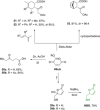The Increasing Value of Biomass: Moving From C6 Carbohydrates to Multifunctionalized Building Blocks via 5-(hydroxymethyl)furfural
- PMID: 33204585
- PMCID: PMC7646257
- DOI: 10.1002/open.202000233
The Increasing Value of Biomass: Moving From C6 Carbohydrates to Multifunctionalized Building Blocks via 5-(hydroxymethyl)furfural
Abstract
Recent decades have been marked by enormous progress in the field of synthesis and chemistry of 5-(hydroxymethyl)furfural (HMF), an important platform chemical widely recognized as the "sleeping giant" of sustainable chemistry. This multifunctional furanic compound is viewed as a strong link for the transition from the current fossil-based industry to a sustainable one. However, the low chemical stability of HMF significantly undermines its synthetic potential. A possible solution to this problem is synthetic diversification of HMF by modifying it into more stable multifunctional building blocks for further synthetic purposes.
Keywords: 5-(hydroxymethyl)furfural; biorefining; carbohydrates; plant biomass; renewable building blocks; sustainable chemistry.
© 2020 The Authors. Published by Wiley-VCH GmbH.
Conflict of interest statement
The authors declare no conflict of interest.
Figures














Similar articles
-
Intermolecular Diels-Alder Cycloadditions of Furfural-Based Chemicals from Renewable Resources: A Focus on the Regio- and Diastereoselectivity in the Reaction with Alkenes.Int J Mol Sci. 2021 Nov 1;22(21):11856. doi: 10.3390/ijms222111856. Int J Mol Sci. 2021. PMID: 34769287 Free PMC article. Review.
-
Industrial Routes from Sugars and Biomass to CMF and Other 5-(Halomethyl)furfurals.ChemSusChem. 2024 Oct 21;17(20):e202400495. doi: 10.1002/cssc.202400495. Epub 2024 Aug 2. ChemSusChem. 2024. PMID: 38899763 Review.
-
Synthesis of 5-(hydroxymethyl)furfural in ionic liquids: paving the way to renewable chemicals.ChemSusChem. 2011 Apr 18;4(4):451-8. doi: 10.1002/cssc.201000374. Epub 2011 Jan 27. ChemSusChem. 2011. PMID: 21275065 Review.
-
Towards Improved Biorefinery Technologies: 5-Methylfurfural as a Versatile C6 Platform for Biofuels Development.ChemSusChem. 2019 Jan 10;12(1):185-189. doi: 10.1002/cssc.201802126. Epub 2018 Nov 27. ChemSusChem. 2019. PMID: 30315683
-
Bio-based building blocks from 5-hydroxymethylfurfural via 1-hydroxyhexane-2,5-dione as intermediate.Chem Sci. 2019 Jun 6;10(24):6024-6034. doi: 10.1039/c9sc01309a. eCollection 2019 Jun 28. Chem Sci. 2019. PMID: 31360410 Free PMC article. Review.
Cited by
-
Benzenoid Aromatics from Renewable Resources.Chem Rev. 2024 Oct 9;124(19):10701-10876. doi: 10.1021/acs.chemrev.4c00087. Epub 2024 Sep 17. Chem Rev. 2024. PMID: 39288258 Free PMC article. Review.
-
Intermolecular Diels-Alder Cycloadditions of Furfural-Based Chemicals from Renewable Resources: A Focus on the Regio- and Diastereoselectivity in the Reaction with Alkenes.Int J Mol Sci. 2021 Nov 1;22(21):11856. doi: 10.3390/ijms222111856. Int J Mol Sci. 2021. PMID: 34769287 Free PMC article. Review.
-
Overcoming the Reversibility in the Diels-Alder Reaction of Bio-Based Electron-Poor Furans with Maleimides Through Liquid-to-Solid Phase Transition.Int J Mol Sci. 2025 Jul 8;26(14):6550. doi: 10.3390/ijms26146550. Int J Mol Sci. 2025. PMID: 40724802 Free PMC article.
-
Improved Electrosynthesis of Biomass Derived Furanic Compounds via Nitroxyl Radical Redox Mediation.Chem Bio Eng. 2024 Jun 6;1(5):427-438. doi: 10.1021/cbe.4c00034. eCollection 2024 Jun 27. Chem Bio Eng. 2024. PMID: 38957543 Free PMC article.
References
-
- None
-
- De Clercq R., Dusselier M., Sels B. F., Green Chem. 2017, 19, 5012–5040;
-
- Clark J. H., Deswarte F. E. I., in Introduction to Chemicals from Biomass (Eds.: Clark J. H., Deswarte F. E. I.), Wiley, Chichester, 2008, pp. 1–20.
-
- Palkovits R., Wright W. R. H., in Chemical Energy Storage (Ed.: Schlögl R.), De Gruyter, Berlin, 2012, pp. 59–86.
-
- See, for example:
Publication types
LinkOut - more resources
Full Text Sources

